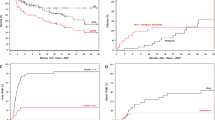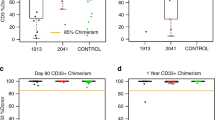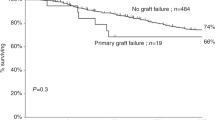Abstract
The purpose of this study was to analyze the outcome of patients with multiple myeloma (MM) responding to initial chemotherapy who received intensification with high-dose therapy/autotransplantation (HDT) as compared to that of those who were continued on standard chemotherapy. From 1 January 1990 to 30 June 1998, 64 patients with MM who were younger than 65 years achieved a response to initial chemotherapy. Due to referral reasons, patients preference or inclusion in trials, 31 patients received HDT as early intensification while 33 were continued on standard chemotherapy. The presenting features were similar in both groups, except for the median age, which was lower in the HDT group (53 vs 58 years, P = 0.007). Complete response – negative immunofixation – (CR) was achieved in 12 of 31 (39%) patients intensified with HDT and in two of 33 (6%) patients who were continued on conventional chemotherapy (P = 0.002). Event-free survival (EFS) was significantly longer in the HDT group (median, 43 vs 21 months; P = 0.007). Overall survival (OS) was not significantly different between groups (median, 62 vs 38 months; P = 0.21). However, patients in the HDT group who achieved CR had an EFS (median, 51 vs 31 months; P = 0.03) as well as an OS (median, not reached vs 50 months; P = 0.0006) significantly longer than those achieving a lower degree of response. In conclusion, this non-randomized study shows that early HDT increases CR rate and prolongs EFS. In addition, these results highlight CR as a crucial step for achieving long-lasting disease control and prolonged survival in patients with MM. Bone Marrow Transplantation (2000) 26, 845–849.
This is a preview of subscription content, access via your institution
Access options
Subscribe to this journal
Receive 12 print issues and online access
$259.00 per year
only $21.58 per issue
Buy this article
- Purchase on Springer Link
- Instant access to full article PDF
Prices may be subject to local taxes which are calculated during checkout






Similar content being viewed by others
References
Bergsagel DE . Chemotherapy of myeloma. In: Malpas JS, Bergsagel DE, Kyle RA, Anderson KC (eds) Myeloma. Biology and Management 2nd edn. Oxford University Press: Oxford 1998 pp 269–302
Gregory WM, Richards MA, Malpas JS . Combination chemotherapy versus melphalan and prednisolone in the treatment of multiple myeloma: an overview of published trials J Clin Oncol 1992 10: 334–342
Myeloma Trialists’ Collaborative Group . Combination chemotherapy versus melphalan plus prednisone as treatment for multiple myeloma: an overview of 6633 patients from 27 randomized trials J Clin Oncol 1998 16: 3822–3842
Hjorth M, Holmberg E, Rödjer S et al. Survival in conventionally treated younger (<60 years) multiple myeloma patients: no improvement during two decades Eur J Haematol 1999 62: 271–277
Attal M, Harousseau JL, Stoppa AM et al. A prospective, randomized trial of autologous bone marrow transplantation and chemotherapy in multiple myeloma New Engl J Med 1996 335: 91–97
Barlogie B, Jagannath S, Vesole DH et al. Superiority of tandem autologous transplantation over standard therapy for previously untreated multiple myeloma Blood 1997 89: 789–793
Palumbo A, Triolo S, Argentino C et al. Dose-intensive melphalan with stem cell support (MEL100) is superior to standard treatment in elderly myeloma patients Blood 1999 94: 1248–1253
Lenhoff S, Hjorth M, Holmberg et al. for the Nordic Myeloma Study Group (NMSG). Impact on survival of high-dose therapy with autologous stem cell support in patients younger than 60 years with newly diagnosed myeloma: a population-based study Blood 2000 95: 7–11
Alexanian R, Weber D, Delasalle K et al. Impact of complete remission after ablative therapy for multiple myeloma Blood 1999 94: (Suppl. 1) 124a
Chronic Leukemia-Myeloma Task Force . National Cancer Institute. Proposed guidelines for protocol studies. II. Plasma cell myeloma Cancer Chemother Rep 1973 4: 145–158
Bladé J, Samson D, Reece D et al. Criteria for evaluating disease response and progression in patients with multiple myeloma treated with high-dose therapy and haematopoieic stem cell transplantation Br J Haematol 1998 102: 1115–1123
Kaplan GL, Meier P . Non-parametric estimation from incomplete observations J Am Stat Assoc 1958 53: 457–481
Peto R, Pike MC . Conservation of the approximation Σ(O−E)2/E in the log-rank test for survival data or tumor incidence data Biometrics 1973 29: 759–784
Oken MM, Leong T, Kay NE et al. The effect of adding interferon (rIFN-alpha2) or high-dose cyclophosphamide to VBMCP to treat multiple myeloma: results from an ECOG phase III trial Blood 1995 86: (Suppl. 1) 441a
Bladé J, San Miguel JF, Fontanillas M et al. Increased conventional chemotherapy does not improve survival in multiple myeloma: long-term results of two PETHEMA trials including 914 patients The Hematol J 2000 (in press
Fermand JP, Ravaud P, Katsahian S et al. High dose therapy (HDT) and autologous blood stem cell (ABSC) transplantation versus conventional treatment in multiple myeloma (MM): results of a randomized trial in 190 patients 55 to 65 years of age Blood 1999 94: (Suppl. 1) 396a
Hjorth M, Holmberg E, Rödjer S, Westin J for the Myeloma Group of Western Sweden . Impact of active and passive exclusions on the results of a clinical trial in multiple myeloma Br J Haematol 1992 80: 55–61
Bladé J, San Miguel JF, Fontanillas M et al. Survival of multiple myeloma patients who are potential candidates for early high-dose therapy intensification/autotransplantation and who were conventionally treated J Clin Oncol 1996 14: 2167–2173
Webb IF, Anderson KC . Hematopoietic stem cell transplantation in multiple myeloma. In: Malpas JS, Bergsagel DE, Kyle RA, Anderson KC (eds) Myeloma. Biology and Management 2nd edn. Oxford University Press: Oxford 1998 pp 311–331
Alexanian R, Dimopoulos MA, Hester J et al. Early myeloablative therapy for multiple myeloma Blood 1994 84: 4278–4282
Vesole D, Tricot G, Jagannath S et al. Autotransplants in multiple myeloma: what have we learned? Blood 1996 88: 838–847
Barlogie B, Jagannath S, Nauche S et al. Long-term follow-up after high-dose therapy for high-risk multiple myeloma Bone Marrow Transplant 1998 21: 1101–1107
Sirohi B, Powles R, Metha J et al. Complete remission rate and outcome after intensive treatment of 177 patients under 75 years of age with IgG myeloma defining a circumscribed disease entity with a new staging system Br J Haematol 1999 107: 656–666
Lahuerta JJ, Martínez-López K, de la Serna J et al. Remission status defined by immunofixation vs electrophoresis after autologous transplantation has a major impact on the outcome of multiple myeloma patients Br J Haematol 2000 109: 438–446
Barlogie B, Desikan R, Munshi N et al. Durable CR in multiple myeloma (MM) in the absence of chromosome 13 deletion and with tandem melphalan-based high-dose therapy (HDT). The Arkansas experience with 1,000 consecutive patients Blood 1999 94: (Suppl. 1) 714a
Barlogie B, Jagannath S, Desikan KR et al. Total therapy with tandem transplants for newly diagnosed multiple myeloma Blood 1999 93: 55–65
Lahuerta JJ, Martínez-López J, Grande C et al. Conditioning regimens in autologous stem cell transplantation for multiple myeloma: a comparative study of the efficacy and toxicity from the Spanish Registry for transplantation in multiple myeloma Br J Haematol 2000 109: 138–147
Acknowledgements
This work was supported in part by grants from Fondo de Investigaciones Sanitarias de la Seguridad Social (FIS 96/0397, 00/0642), from Comissionat per a Universitats i Recerca de la Generalitat de Catalunya (SGR9800111) and José Carreras International Leukemia Foundation (FIJC-00/P-CR, FIJC-00/P-EM).
Author information
Authors and Affiliations
Rights and permissions
About this article
Cite this article
Bladé, J., Esteve, J., Rives, S. et al. High-dose therapy autotransplantation/intensification vs continued standard chemotherapy in multiple myeloma in first remission. Results of a non-randomized study from a single institution. Bone Marrow Transplant 26, 845–849 (2000). https://doi.org/10.1038/sj.bmt.1702622
Received:
Accepted:
Published:
Issue Date:
DOI: https://doi.org/10.1038/sj.bmt.1702622
Keywords
This article is cited by
-
The outcome of high-dose chemotherapy and auto-SCT in patients with multiple myeloma: a UK/Ireland and European benchmarking comparative analysis
Bone Marrow Transplantation (2011)
-
High-dose chemotherapy with autologous stem cell transplantation for multiple myeloma: what predicts the outcome? Experience from a developing country
Bone Marrow Transplantation (2009)
-
Impact of lenalidomide therapy on stem cell mobilization and engraftment post-peripheral blood stem cell transplantation in patients with newly diagnosed myeloma
Leukemia (2007)
-
High-dose therapy and autologous stem cell transplantation for multiple myeloma poorly responsive to initial therapy
Bone Marrow Transplantation (2004)
-
Single agent dexamethasone for pre-stem cell transplant induction therapy for multiple myeloma
Bone Marrow Transplantation (2004)



